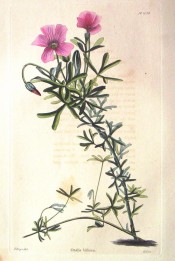Oxalis bifurca Lodd.
Half-hardy bulbous perennial with leaves composed of 3 linear leaflets, bilobed, deeply incised to about half their length, to about 8mm long and .5mm wide, smooth above, sparsely hairy beneath. Erect or procumbent branched stems, to 30cm, bear solitary, purple-red flowers, to 1.2cm across, with yellow-green throats, on stalks to 8cm long. Late summer to autumn flowering in Australia. [RHSD, Beadle, FNSW].
Horticultural & Botanical History
Introduced to Britain in 1791. [JD]. ‘Native of the Cape of Good Hope, whence it has been lately introduced. The stems are from six inches to a foot in length, more or less leafy and branching: they are downy as are all parts of the plant. The flower stalks are single and longer than the leaves; both have a joint at their insertion, and the stalks have two small subulate opposite stipules near the flower. The leaves are ternate and forked full half their length.’ [LBC no.1056/1826].
History at Camden Park
Introduced to the gardens before 1843. Listed in all published catalogues [B.364/1843]. I have not seen this plant at Camden Park but it is very locally naturalised at nearby St. James’ Cemetery, Campbelltown. It has now been reintroduced to the gardens and is thriving. It is probable that most of the Oxalis species grown in the gardens were obtained from Loddiges’ nursery, a major supplier to Camden Park, before 1843. Most of them are figured in Conrad Loddiges’ Botanical Cabinet. Exceptions are Oxalis rosea, known to have arrived on the ‘Sovereign’ in 1831, and the later introductions Oxalis elegans, obtained from Veitch’s nursery, and Oxalis lupinifolia.
Notes
Oxalis bifurca Eckl. & Zeyh. (1834) = O. heterophylla Eckl. & Zeyh. but is probably not Macarthur’s plant.
Published Feb 17, 2009 - 04:52 PM | Last updated Jan 27, 2010 - 03:02 PM
| Family | Oxalidaceae |
|---|---|
| Category | |
| Region of origin | South Africa |
| Synonyms | |
| Common Name | |
| Name in the Camden Park Record | Oxalis bifurcata |
| Confidence level | high |


